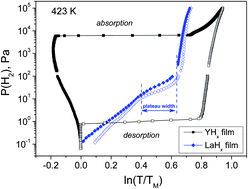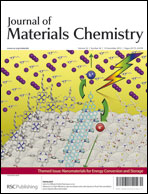The (de-)hydrogenation properties of La1−zYzHx (z = 0, 0.4, 1) thin films during the dihydride–trihydride transition were investigated by means of hydrogenography. We show that La-rich films, i.e. LaHx and La0.6Y0.4Hx, are almost hysteresis free in the temperature range 423–523 K. This appears to be due to a small and/or negative volume expansion and the absence of the structure transformation on hydrogenation. The presence of the small difference between absorption and desorption sloping plateaus in these films is assigned to minor plastic deformations due to the substrate clamping. In contrast, YHx films, which expand by about 12% in volume on hydrogenation and which exhibit an fcc–hex structure transformation, show a huge (2–3 orders of magnitude) hysteresis. This giant hysteresis is caused, according to our stress–strain analysis, by the clamping induced mechanical work done by the film during (de-)hydrogenation and the reorientation required to maintain the preferential orientation during the fcc–hex structure transformation. Using our stress–strain model, improved by an additional structural parameter (ΔGfcc–hex), we were able to reproduce the size of the hysteresis in both thin and thick YHx films measured at 523 K and at 295 K, respectively.

You have access to this article
 Please wait while we load your content...
Something went wrong. Try again?
Please wait while we load your content...
Something went wrong. Try again?


 Please wait while we load your content...
Please wait while we load your content...